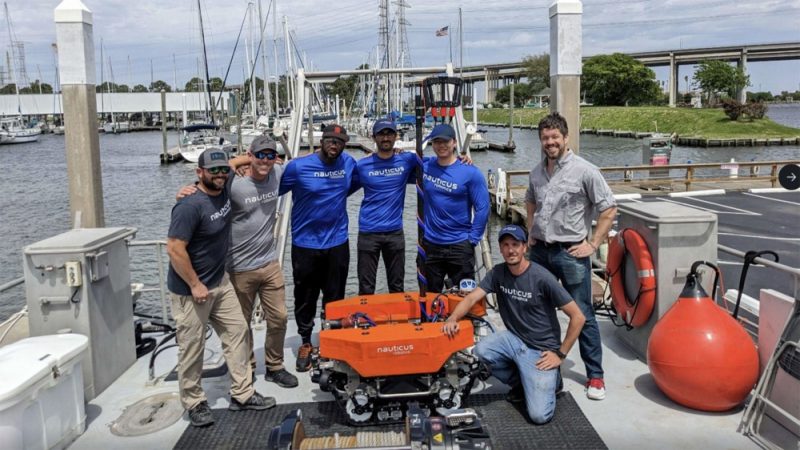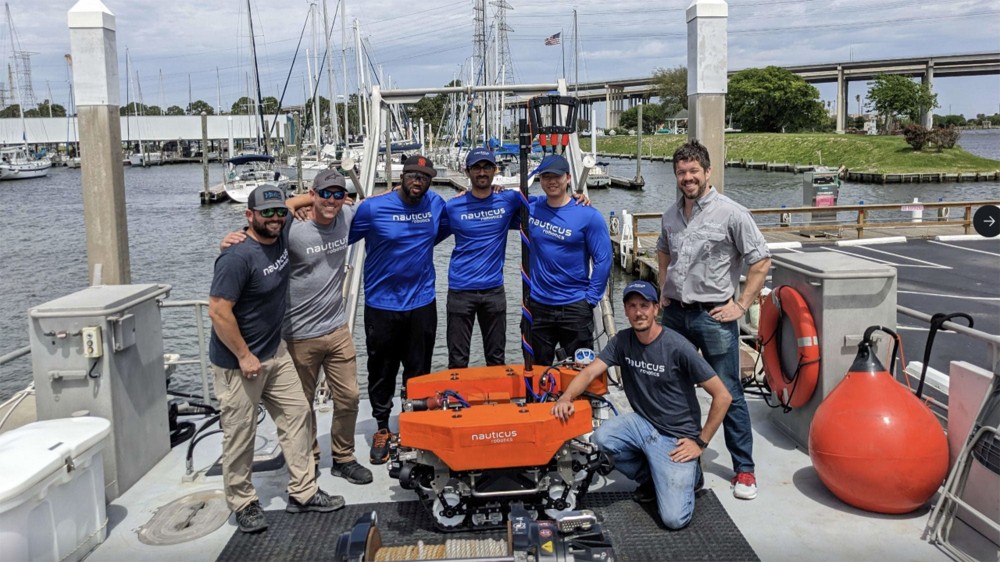The Terranaut is a new mine-hunting bot designed for beaches

On April 19, Nauticus Robotics announced that its work on the Terranaut, an amphibious machine designed to defeat explosive mines for the Defense Innovation Unit, had cleared its initial phase and was progressing to further development. The machine builds on Nauticus’ previous work with aquatic uncrewed vehicles. It fits into a holistic picture of untethered, autonomous underwater operations, where tools developed for commercial underwater work inform machines specifically built to tackle the special military needs below the ocean’s surface.
Nauticus teased this announcement of Terranaut on social media with a picture of tread lines on a beach leading into the ocean surface.
DIU, or the Defense Innovation Unit, is an organization within the larger Department of Defense designed to pull innovations from the commercial tech world into military use. Rather than reinventing the wheel, it is built to look at wagon wheels it could simply buy for its chariots.
“DIU gets intrigued when you have some commercial-facing technologies that they think they could orient towards a defense mission,” Nauticus CEO Nicolaus Radford tells Popular Science. “A lot of people focus on our big orange robots. But what’s between our robots’ ears is more important.”
“So DIU is like, all right, you guys have made some commercial progress,” Radford adds. “You’ve got a commercial platform both in software and hardware. Maybe we can modify it a little bit towards some of these other missions that we’re interested in.”
In Nauticus’ announcement, they emphasized that Terranaut is being developed as an autonomous mine countermeasure robot, which can work in beaches and surf zones. These are the exact kind of areas where Marines train and plan to fight, especially in Pacific island warfare. Terranaut, as promised, will both swim and crawl, driven by an autonomous control system that can receive human direction through acoustic communication.
The Terranaut can navigate on treads and with powerful thrusters, with plans for manipulator arms that can emerge from the body to tackle any tasks, like disassembling an underwater mine.

“It’s able to fly through the water column and then also change its buoyancy in a way that it can get appreciable traction,” says Radford. “Let’s say you’re driving on the sub-sea bed and you encounter a rock. Well, you don’t know how long the rock is, it could take you a while to get around it, right?” The solution in that case would be to go above it.
Much of the work that informed the creation and design of Terranaut comes from Nauticus’ work on Aquanaut, which is a 14.5-foot-long submersible robot that can operate at depths of almost 10,000 feet, and in regular versions at distances of up to 75 miles. Powered by an electric motor and carrying over 67 kilowatt hours of battery power, the aquanaut moves at a baseline speed of 3 knots, or almost 3.5 mph, underwater, and it can last on its battery power for over four days continuously. But what most distinguishes Aquanaut is its retractable manipulator arms that fold into its body when not needed, and its ability to operate without the direct communications control through an umbilical wire like another undersea robot.
The Aquanaut can perceive its environment thanks to sonar, optical sensors in stereo, native 3D cloud point imagery, and other sensors. This data can be collected at a higher resolution than is transmittable while deep undersea, with the Aquanaut able to surface or dock and transmit higher volumes and density of data faster
Like the Aquanaut, the Terranaut does not have an umbilical connecting it to a boat.
Typically, boats have umbilicals connecting them to robots “because you have to have an operator with joysticks looking at HD monitors, being able to drive this thing,” says Radford. “What we said is ‘let’s throw all that out.’ We can create a hybrid machine that doesn’t need an umbilical that can swim really far, but as it turns out, people just don’t want to take pictures. They want to pick something up, drop something off, cut something, plug something in, and we developed a whole new class of subsea machines that allows you to do manipulation underwater without the necessity of an umbilical.”
Removing the umbilical frees up the design for what kind of ships can launch and manage underwater robotics. It also comes with a whole new set of problems, like how to ensure that the robot is performing the tasks asked of it by a human operator, now that the operator is not driving but directing the machine. Communication through water is hard, as radio signals and light signals are both limited in range and efficacy, especially below the ocean’s surface.
Solving these twin problems means turning to on-board autonomy, and acoustic controls.
“We have data rates akin to dial up networking in 1987,” says Radford. “You’re not gonna be streaming HD video underwater with a Netflix server, but there are ways in which you can send representative information in the 3D environment around you back to an operator, and then the operator flies the autopilot of the robot around.”
That means, in essence, that the robot itself is largely responsible for managing the specifics of its ballast and direction, and following commands transmitted acoustically through the water. In return it sends information back, allowing a human to select actions and behaviors already loaded onto the robot.
Like the Aquanaut before it, the Terranaut will come preloaded with the behaviors needed to navigate its environment and perform the tasks assigned to it. Once the Terranaut rolls through surfy shallows, onto beaches, and into visual range, it will apply those tools, adaptive autonomy and remote human guidance, to taking apart deadly obstacles, like underwater explosives.
“I think this is the beginning of a very vibrant portfolio of aquatic drones that I hope captures the public’s imagination on what’s possible underwater. I think it’s just as fascinating as space, if not more so, because it’s so much more near to us,” said Radford. “You know, five percent of the ocean seabed has been explored on any level. We live on an ocean planet stupidly called Earth.”










